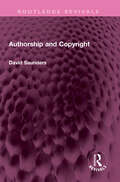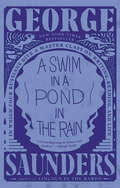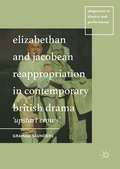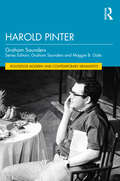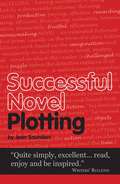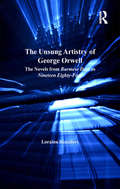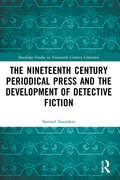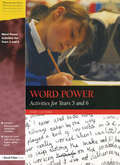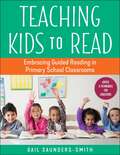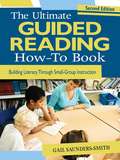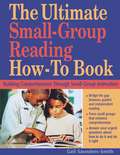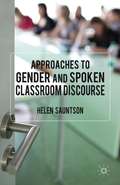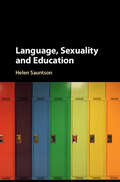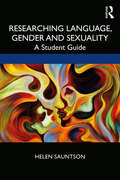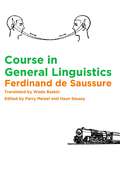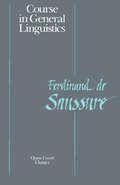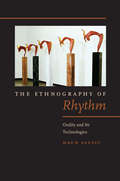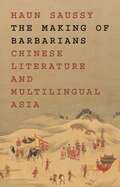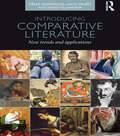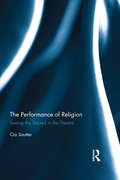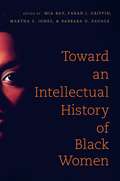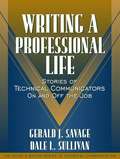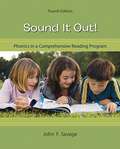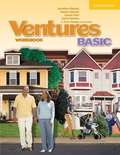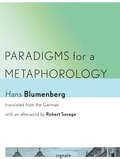- Table View
- List View
Authorship and Copyright (Routledge Revivals)
by David SaundersFirst published in 1992, Authorship and Copyright traces the history of constructions of authorship as a legal reality. It offers an alternative to the two mainstream interpretations that have traditionally been assigned to authorship: the Romantic dialectical ‘birth of the author’ or the language-based post-structuralist ‘death of the author.’ Saunders examines the shortcomings of both schemes by arguing that they impose an arbitrary philosophical direction on the history of authorship and the law of copyright. Saunders addresses the issues relating to copyright and the construction of authorship as a legal status. Combining information and polemic, the author explores such matters as the historical and theoretical relations of copyright and the droit moral, the aestheticization of the law and the juridification of aesthetics, and the argument that authorship as a legal reality is a historically contingent and variable arrangement that cannot be separated from its cultural and juridical context. This book will be of interest to students of law, literature and philosophy.
A Swim in a Pond in the Rain: In Which Four Russians Give a Master Class on Writing, Reading, and Life
by George SaundersFrom the New York Times bestselling, Booker Prize–winning author of Lincoln in the Bardo and Tenth of December comes a literary master class on what makes great stories work and what they can tell us about ourselves—and our world today.For the last twenty years, George Saunders has been teaching a class on the Russian short story to his MFA students at Syracuse University. In A Swim in a Pond in the Rain, he shares a version of that class with us, offering some of what he and his students have discovered together over the years. Paired with iconic short stories by Chekhov, Turgenev, Tolstoy, and Gogol, the seven essays in this book are intended for anyone interested in how fiction works and why it&’s more relevant than ever in these turbulent times.In his introduction, Saunders writes, &“We&’re going to enter seven fastidiously constructed scale models of the world, made for a specific purpose that our time maybe doesn&’t fully endorse but that these writers accepted implicitly as the aim of art—namely, to ask the big questions, questions like, How are we supposed to be living down here? What were we put here to accomplish? What should we value? What is truth, anyway, and how might we recognize it?&” He approaches the stories technically yet accessibly, and through them explains how narrative functions; why we stay immersed in a story and why we resist it; and the bedrock virtues a writer must foster. The process of writing, Saunders reminds us, is a technical craft, but also a way of training oneself to see the world with new openness and curiosity.A Swim in a Pond in the Rain is a deep exploration not just of how great writing works but of how the mind itself works while reading, and of how the reading and writing of stories make genuine connection possible.
Elizabethan and Jacobean Reappropriation in Contemporary British Drama
by Graham SaundersThis book examines British playwrights' responses to the work of Shakespeare and his contemporaries since 1945, from Tom Stoppard's Rosencrantz and Guildenstern are Dead to Sarah Kane's Blasted and Jez Butterworth's Jerusalem. Using the work of Julie Sanders and others working in the fields of Adaptation Studies and intertextual criticism, it argues that this relatively neglected area of drama, widely considered to be adaptation, should instead be considered as appropriation - as work that often mounts challenges to the ideologies and orthodoxies within Elizabethan and Jacobean drama, and questions the legitimacy and cultural authority of Shakespeare's legacy. The book discusses the work of Howard Barker, Peter Barnes, Edward Bond, Howard Brenton, David Edgar, Elaine Feinstein and the Women's Theatre Group, David Greig, Sarah Kane, Dennis Kelly, Bernard Kopps, Charles Marowitz, Julia Pascal and Arnold Wesker.
Harold Pinter (Routledge Modern and Contemporary Dramatists)
by Graham SaundersHarold Pinter provides an up-to-date analysis and reappraisal concerning the work of one of the most studied and performed dramatists in the world. Drawing extensively from The Harold Pinter Archive at the British Library as well as reviews and other critical materials, this book offers new insights into previously established views about his work. The book also analyses and reappraises specific key historical and contemporary productions, including a selection of Pinter’s most significant screenplays. In particular, this volume seeks to assess Pinter’s critical reputation and legacy since his death in 2008. These include his position as a political writer and political activist – from disassociation and neutrality on the subject until relatively late in his career when his drama sought to explicitly address questions of political dissent and torture by totalitarian regimes. The book revisits some familiar territories such as Pinter’s place as a British absurdist and the role memory plays in his work, but it also sets out to explore new territories such as Pinter’s changing attitudes towards gender in the light of #MeToo and queer politics and how in particular a play such as The Caretaker (1960) through several key productions has brought the issues of race into sharper focus. Part of the Routledge Modern and Contemporary Dramatist series, Harold Pinter provides an essential and accessible guide to the dramatists’ work.
Successful Novel Plotting
by Jean SaundersWhat is it about a good book that hooks the reader and makes them want more? A good plot. Every best-selling author from Agatha Christie to Terry Pratchett knows the importance of a strong story. But for the budding author it can be daunting and even confusing.How do you turn that seed of an idea into a great epic? This authoritative guide will help steer new writers through the minefield of the writing process. Using examples from her own work, and that of other top authors, Jean explains how to create memorable characters, generate cliffhangers and keep up a pace that will hook readers. And when you've done that, she even gives advice on how to work with publishers and editors to make your novel a best seller. About the Author Jean Saunders is an award-winning author of more than 600 short stories and 100 novels from contemporary fiction and historical romance to crime and erotica. She's best-known worldwide as Rowena Summers, the writer of many novels based in the West Country, and Rachel Moore, author of wartime sagas set in Cornwall.Her WW1 saga Bannister Girls was short-listed for the Romantic Novel of the Year award. A former chairman of the Romantic Novelists Association, Jean now lectures on writing and writes a monthly column for Writing Magazine. Successful Novel Plotting is the most recent in her series of how to guide books for writers.
The Unsung Artistry of George Orwell: The Novels from Burmese Days to Nineteen Eighty-Four
by Loraine SaundersIn a timely and radically new reappraisal of George Orwell's fiction, Loraine Saunders reads Orwell's novels as tales of successful emancipation rather than as chronicles of failure. Contending that Orwell's novels have been undervalued as works of art, she offers extensive textual analysis to reveal an author who is in far more control of his prose than has been appreciated. Persuasively demonstrating that Orwell's novels of the 1930s such as A Clergyman's Daughter and Keep the Aspidistra Flying are no less important as literature than Animal Farm and Nineteen Eighty-Four, Saunders argues they have been victims of a critical tradition whose practitioners have misunderstood Orwell's narrative style, failed to appreciate Orwell's political stance, and were predisposed to find little merit in Orwell's novels. Saunders devotes significant attention to George Gissing's influence on Orwell, particularly with regard to his representations of women. She also examines Orwell's socialism in the context of the political climate of the 1930s, finding that Orwell, in his successful negotiation of the fine balance between art and propaganda, had much more in common with Charlie Chaplin than with writers like Stephen Spender or W. H. Auden. As a result of Saunders's detailed and accessible analysis, which illuminates how Orwell harmonized allegory with documentary, polyphonic voice with monophonic, and elegy with comedy, Orwell's contributions to the genre of political fiction are finally recognized.
The Nineteenth Century Periodical Press and the Development of Detective Fiction (Routledge Studies in Nineteenth Century Literature)
by Samuel SaundersThis book re-imagines nineteenth-century detective fiction as a literary genre that was connected to, and nurtured by, contemporary periodical journalism. Whilst ‘detective fiction’ is almost universally-accepted to have originated in the nineteenth century, a variety of widely-accepted scholarly narratives of the genre’s evolution neglect to connect it with the development of a free press. The volume traces how police officers, detectives, criminals, and the criminal justice system were discussed in the pages of a variety of magazines and journals, and argues that this affected how the wider nineteenth-century society perceived organised law enforcement and detection. This, in turn, helped to shape detective fiction into the genre that we recognise today. The book also explores how periodicals and newspapers contained forgotten, non-canonical examples of ‘detective fiction’, and that these texts can help complicate the narrative of the genre’s evolution across the mid- to late nineteenth century.
Word Power: Activities for Years 5 and 6
by Terry SaundersFirst Published in 2005. Routledge is an imprint of Taylor & Francis, an informa company.
Teaching Kids to Read: Embracing Guided Reading in Primary School Classrooms
by Gail Saunders-Smith"A solid resource to help teachers understand the basic foundation for literacy development through guided reading in the primary grade." —Patti Ulshafer, first-grade teacherDevelop successful readers with these strategies for before, during, and after reading. In Teaching Kids to Read, Gail Saunders-Smith describes the cognitive processes of emergent readers and provides educators with clear guidelines for promoting reading comprehension with small groups of young learners. A variety of exercises included helps children to locate, record, retrieve, and manipulate information from texts while enabling teachers to measure how students respond in oral, written, graphic, and three-dimensional forms. Topics covered include:AliteracyCoaching statementsElements of craftFalse positive readersFresh textGuided readingInstructional practiceMetacognitionPhonemic awarenessSelf-monitoringShared readingSight wordsStudy skillsTeacher talkWorkable wordsand more!
Ultimate Guided Reading How-To Book: Building Literacy Through Small-Group Instruction
by Gail Saunders-SmithGeared towards primary school teachers to understand the foundation for literacy development
The Ultimate Small-Group Reading How-To Book: Building Comprehension Through Small-Group Instruction
by Gail Saunders-SmithAs students gain confidence and skills in guided reading, what is the next step to helping them become strong, independent readers? Small-group reading sessions. By working in small groups, students will be able to explore longer text and build their literacy skills with confidence. Literacy expert Gail Saunders-Smith demonstrates through the methods in this book how educators can advance students from small-group reading to silent reading, all while building reading comprehension.Ideal for teachers of emergent readers, The Ultimate Small-Group Reading How-To Book demonstrates how to develop successful readers through step-by-step, small-group reading instruction that focuses on vocabulary, comprehension, and fluency. Inside are tools for teachers to help them:Set up small-group mini-lessons and discussion of textsProvide tools for students to help investigate narrative textsEngage students to evaluate expository textsDevelop students’ skills in defining literary elements such as characters, setting, and plotAnd much moreHelp students become independent readers with these strategies for use before, during, and after guided reading!
Approaches to Gender and Spoken Classroom Discourse
by Helen SauntsonGender is a hotly debated topic in the field of education. The role that language plays in educational contexts especially in the classroom has long been acknowledged. Innovatively combining approaches in the analysis of classroom discourse this book offers rich empirical findings as well as being theoretically interesting and valuable.
Language, Sexuality and Education
by Helen SauntsonPresenting a range of data obtained from secondary schools in the UK and US, this path-breaking book explores the role played by language in constructing sexual identities. Analysing the often complex ways in which homophobia, heterosexism and heteronormativity are enacted within school contexts, it shows that by analysing language, we can discover much about how educators and students experience sexual diversity in their schools, how sexual identities are constructed through language, and how different statuses are ascribed to different sexual identities.
Researching Language, Gender and Sexuality: A Student Guide
by Helen SauntsonResearching Language, Gender and Sexuality leads students through the process of undertaking research in order to explore how gender and sexuality are represented and constructed through language. Drawing on international research, Sauntson incorporates a fluid understanding of genders and sexualities and includes research on a diverse range of identities. This accessible guidebook offers an outline of the practical steps and ethical guidelines involved when gathering linguistic data for the purpose of investigating gender and sexuality. Each chapter contains up-to-date information and empirical case studies that relate to a range of topics within the field of language, gender and sexuality, as well as suggestions for how students could practically research the areas covered. Student-friendly, this is essential reading for undergraduate and postgraduate students of English language, linguistics and gender studies.
Course in General Linguistics (Bloomsbury Revelations Ser.)
by Ferdinand de SaussureThe founder of modern linguistics, Ferdinand de Saussure inaugurated semiology, structuralism, and deconstruction and made possible the work of Jacques Derrida, Roland Barthes, Michel Foucault, and Jacques Lacan, thus enabling the development of French feminism, gender studies, New Historicism, and postcolonialism. Based on Saussure's lectures, Course in General Linguistics (1916) traces the rise and fall of the historical linguistics in which Saussure was trained, the synchronic or structural linguistics with which he replaced it, and the new look of diachronic linguistics that followed this change. Most important, Saussure presents the principles of a new linguistic science that includes the invention of semiology, or the theory of the "signifier," the "signified," and the "sign" that they combine to produce.This is the first critical edition of Course in General Linguistics to appear in English and restores Wade Baskin's original translation of 1959, in which the terms "signifier" and "signified" are introduced into English in this precise way. Baskin renders Saussure clearly and accessibly, allowing readers to experience his shift of the theory of reference from mimesis to performance and his expansion of poetics to include all media, including the life sciences and environmentalism. An introduction situates Saussure within the history of ideas and describes the history of scholarship that made Course in General Linguistics legendary. New endnotes enlarge Saussure's contexts to include literary criticism, cultural studies, and philosophy.
Course in General Linguistics
by Ferdinand La SaussureThe Cours de linguistique generale, reconstructed from students' notes after Saussure's death in 1913, founded modern linguistic theory by breaking the study of language free from a merely historical and comparativist approach. Saussure's new method, now known as Structuralism, has since been applied to such diverse areas as art, architecture, folklore, literary criticism, and philosophy.
The Ethnography of Rhythm: Orality and Its Technologies
by Haun SaussyWho speaks? The author as producer, the contingency of the text, intertextuality, the “device”—core ideas of modern literary theory—were all pioneered in the shadow of oral literature. Authorless, loosely dated, and variable, oral texts have always posed a challenge to critical interpretation. When it began to be thought that culturally significant texts—starting with Homer and the Bible—had emerged from an oral tradition, assumptions on how to read these texts were greatly perturbed. Through readings that range from ancient Greece, Rome, and China to the Cold War imaginary, The Ethnography of Rhythm situates the study of oral traditions in the contentious space of nineteenth- and twentieth-century thinking about language, mind, and culture. It also demonstrates the role of technologies in framing this category of poetic creation. By making possible a new understanding of Maussian “techniques of the body” as belonging to the domain of Derridean “arche-writing,” Haun Saussy shows how oral tradition is a means of inscription in its own right, rather than an antecedent made obsolete by the written word or other media and data-storage devices.
The Making of Barbarians: Chinese Literature and Multilingual Asia (Translation/Transnation #49)
by Haun SaussyA groundbreaking account of translation and identity in the Chinese literary tradition before 1850—with important ramifications for todayDebates on the canon, multiculturalism, and world literature often take Eurocentrism as the target of their critique. But literature is a universe with many centers, and one of them is China. The Making of Barbarians offers an account of world literature in which China, as center, produces its own margins. Here Sinologist and comparatist Haun Saussy investigates the meanings of literary translation, adaptation, and appropriation on the boundaries of China long before it came into sustained contact with the West.When scholars talk about comparative literature in Asia, they tend to focus on translation between European languages and Chinese, Korean, and Japanese, as practiced since about 1900. In contrast, Saussy focuses on the period before 1850, when the translation of foreign works into Chinese was rare because Chinese literary tradition overshadowed those around it.The Making of Barbarians looks closely at literary works that were translated into Chinese from foreign languages or resulted from contact with alien peoples. The book explores why translation was such an undervalued practice in premodern China, and how this vast and prestigious culture dealt with those outside it before a new group of foreigners—Europeans—appeared on the horizon.
Introducing Comparative Literature: New Trends and Applications
by Haun Saussy César Domínguez Darío VillanuevaIntroducing Comparative Literature is a comprehensive guide to the field offering clear, concise information alongside useful analysis and examples. It frames the introduction within recent theoretical debates and shifts in the discipline whilst also addressing the history of the field and its practical application. Looking at Comparative Literature within the context of globalization, cosmopolitanism and post or transnationalism, the book also offers engagement and comparison with other visual media such as cinema and e-literature. The first four chapters address the broad theoretical issues within the field such as 'interliterary theory', decoloniality, and world literature, while the next four are more applied, looking at themes, translation, literary history and comparison with other arts. This engaging guide also contains a glossary of terms and concepts as well as a detailed guide to further reading.
The Performance of Religion: Seeing the sacred in the theatre
by Cia SautterThe performing arts are uniquely capable of translating a vision of an ideal or sacred reality into lived practice, allowing an audience to confront deeply held values and beliefs as they observe a performance. However, there is often a reluctance to approach distinctly religious topics from a performance studies perspective. This book addresses this issue by exploring how religious values are acted out and reflected on in classic Western theatre, with a particular emphasis on the plays put on during the Globe Theatre‘s yearlong season of 'Shakespeare and the Bible'. Looking at plays such as Much Ado About Nothing, Dr. Faustus and Macbeth, each chapter includes ethnographic overviews of the performance of these plays as well as historical and theological perspectives on the issues they address. The author also utilizes scholarship from other academics, such as Paul Tillich and Martin Buber, in examining the relationship between art and culture. This helps readers of this book to look at religion in culture, and raise questions and explore ideas about how people appraise their religious values through an encounter with a performance. The Performance of Religion: Seeing the sacred in the theatre treads new ground in bringing performance and religious studies scholarship into direct conversation with one another. As such, it is essential reading for any academic with an interest in theology, religion and ethics and their expression in culture through the performing arts.
Toward an Intellectual History of Black Women
by Barbara Dianne Savage Martha S. Jones Mia Bay Farah J. GriffinDespite recent advances in the study of black thought, black women intellectuals remain often neglected. This collection of essays by fifteen scholars of history and literature establishes black women's places in intellectual history by engaging the work of writers, educators, activists, religious leaders, and social reformers in the United States, Africa, and the Caribbean. Dedicated to recovering the contributions of thinkers marginalized by both their race and their gender, these essays uncover the work of unconventional intellectuals, both formally educated and self-taught, and explore the broad community of ideas in which their work participated. The end result is a field-defining and innovative volume that addresses topics ranging from religion and slavery to the politicized and gendered reappraisal of the black female body in contemporary culture. Contributors are Mia E. Bay, Judith Byfield, Alexandra Cornelius, Thadious Davis, Corinne T. Field, Arlette Frund, Kaiama L. Glover, Farah J. Griffin, Martha S. Jones, Natasha Lightfoot, Sherie Randolph, Barbara D. Savage, Jon Sensbach, Maboula Soumahoro, and Cheryl Wall.
Writing a Professional Life: Stories of Technical Communicators On and Off the Job
by Gerald J. Savage Dale L. SullivanThis is the first collection of narratives by practicing technical communicators telling their own personal stories about the workplace and their lives on the job. The authors portray a wide range of jobs: writers, editors, interface designers, marketing writers, and trainers working in 9 different technical fields, including software, R&D, engineering , medicine, transportation, and telecommunications. The stories vividly demonstrate the unique power of narrative as a teaching and learning tool. Unlike fabricated cases, these real-life narratives show new and veteran technical writers at work on the job, dealing with tasks, clients, and co-workers, and revealing their insights, values, and attitudes about their work. The stories also show the skills required in the profession and the ethical and other issues raised in the course of the workday. For anyone interested in technical communication and professional writing.
Sound it Out!: Phonics in a Comprehensive Reading Program (Fourth Edition)
by John F. SavageThis book covers both the content of phonics and the ways in which it can be effectively integrated into a comprehensive classroom reading program. The text contains practical teaching suggestions for phonemic awareness, phonics, and spelling. The fourth edition features an increased emphasis on technology as it applies to phonics instruction, along with additional focus placed on helping children who have trouble learning acquire basic phonics skills.
Ventures Basic: Workbook
by K. Lynn Savage Sylvia Ramirez Donna Price Dennis Johnson Gretchen BitterlinThe Workbook provides reinforcement exercises for each lesson in the Student's Book, an answer key for self-study, grammar charts, and examples of a variety of forms and documents.
Paradigms for a Metaphorology
by Robert Savage Hans Blumenberg"Paradigms for a Metaphorology may be read as a kind of beginner's guide to Blumenberg, a programmatic introduction to his vast and multifaceted oeuvre. Its brevity makes it an ideal point of entry for readers daunted by the sheer bulk of Blumenberg's later writings, or distracted by their profusion of historical detail. Paradigms expresses many of Blumenberg's key ideas with a directness, concision, and clarity he would rarely match elsewhere. What is more, because it served as a beginner's guide for its author as well, allowing him to undertake an initial survey of problems that would preoccupy him for the remainder of his life, it has the additional advantage that it can offer us a glimpse into what might be called the ‛genesis of the Blumenbergian world.’"-from the Afterword by Robert SavageWhat role do metaphors play in philosophical language? Are they impediments to clear thinking and clear expression, rhetorical flourishes that may well help to make philosophy more accessible to a lay audience, but that ought ideally to be eradicated in the interests of terminological exactness? Or can the images used by philosophers tell us more about the hopes and cares, attitudes and indifferences that regulate an epoch than their carefully elaborated systems of thought?In Paradigms for a Metaphorology, originally published in 1960 and here made available for the first time in English translation, Hans Blumenberg (1920-1996) approaches these questions by examining the relationship between metaphors and concepts. Blumenberg argues for the existence of "absolute metaphors" that cannot be translated back into conceptual language. These metaphors answer the supposedly naïve, theoretically unanswerable questions whose relevance lies quite simply in the fact that they cannot be brushed aside, since we do not pose them ourselves but find them already posed in the ground of our existence. They leap into a void that concepts are unable to fill.An afterword by the translator, Robert Savage, positions the book in the intellectual context of its time and explains its continuing importance for work in the history of ideas.
